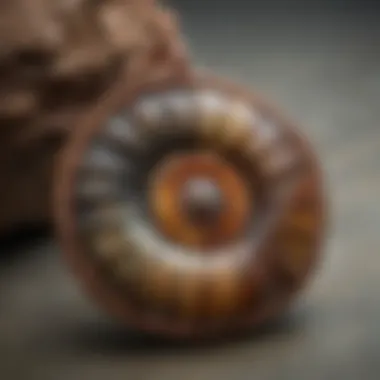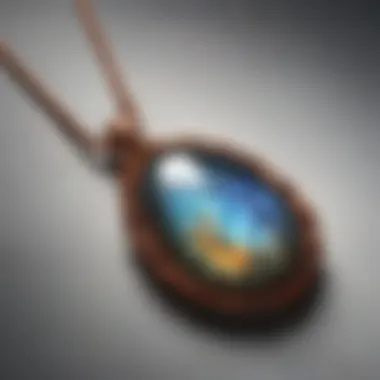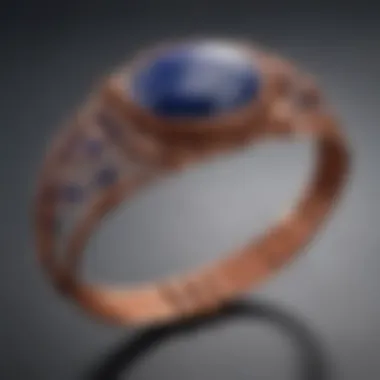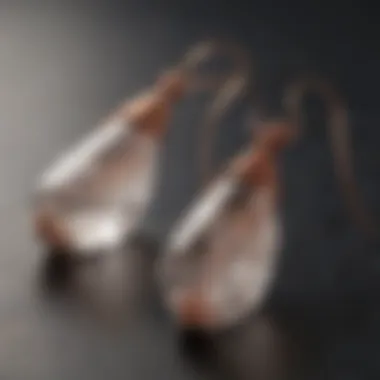Mastering the Art of Copper Wire Wrapping for Geological Enthusiasts


Rock and Fossil Identification
This section aims to provide a detailed overview of various types of rocks and fossils, the key characteristics to look for during identification, and the essential tools required for this process. Types of rocks and fossils can range from sedimentary to igneous and metamorphic rocks, each exhibiting distinct properties that aid in their identification. For fossils, they can be categorized as body or trace fossils, contributing to the rich diversity found in geological specimens. Understanding the characteristics of rocks and fossils, such as color, texture, hardness, and fossil imprints, is fundamental in accurate identification, guiding enthusiasts in their crafting endeavors. Utilizing the right tools for identification, such as magnifying glasses, streak plates, and rock hammers, enhances the process and ensures precision in discerning the unique features of each specimen.
Collecting Tips and Techniques
In this section, we delve into the best practices for collecting rocks and fossils, strategies for locating prime collecting sites, and methods for safely extracting specimens without causing damage. Adopting best practices during the collection process involves respecting nature, obtaining necessary permits for collecting in designated areas, and adhering to ethical guidelines that prioritize conservation efforts. Locating prime collecting sites requires research and exploration, focusing on geological maps, land formations, and expert advice to identify areas abundant in rock and fossil specimens. Learning how to safely extract specimens entails using tools with precision, practicing gentle handling techniques, and documenting the find's location for future reference, maintaining the integrity of the collected specimens for further study and display.
Preservation and Display
Under this category, we explore techniques for preserving rocks and fossils to maintain their integrity, proper storage methods to safeguard specimens over time, and creative display ideas that showcase these geological marvels. Employing effective preservation techniques involves using stabilizing agents, protective coatings, and climate-controlled environments to prevent degradation and maintain the authentic beauty of rocks and fossils. Understanding proper storage methods includes storing specimens in acid-free containers, organizing them by type or location, and labeling each piece with relevant details for easy retrieval and reference. When considering creative display ideas, enthusiasts can experiment with shadow boxes, acrylic casings, and themed displays that highlight the unique features and stories behind each rock or fossil, offering viewers a captivating glimpse into the geological world.
Geological Insights
In this final section, we delve into the intricate world of geological formations and processes, uncover the historical significance behind rocks and fossils, and celebrate notable discoveries that have shaped the field of geology. Exploring geological formations and processes unveils the forces of nature that have sculpted the Earth's landscape over millions of years, showcasing the dynamic interactions that result in diverse rock formations and fossil deposits. Understanding the historical significance of rocks and fossils sheds light on their role in unraveling Earth's history, offering clues to past environments, living organisms, and evolutionary changes that have occurred over geological time scales. Delving into notable discoveries in the field, we celebrate the contributions of pioneers and modern researchers who have unearthed groundbreaking findings, expanding our understanding of Earth's geological past and enriching our appreciation for the intricate beauty of rocks and fossils.
Introduction
The mesmerizing fusion of copper wire wrapping and geological elements unlocks a realm of artistic expression that captivates both the jewelry crafting and geology communities. In this article, we embark on a detailed journey into the art of copper wire wrapping tailored for geology enthusiasts. By exploring the techniques, tools, and creative pathways entwined within this craft, we unravel the possibilities of crafting unique pieces that showcase the beauty of rocks and fossils.
Understanding Copper Wire Wrapping
Origins of Copper Wire Wrapping
Delving into the origins of copper wire wrapping unveils a rich history that intertwines craftsmanship with geological allure. The distinctive appeal of utilizing copper wire lies in its malleability and conductivity, allowing artisans to sculpt intricate designs around geological treasures. The ancient roots of this technique trace back to traditional metalworking practices, evolving over time to become a favored method in jewelry making. Despite its centuries-old legacy, copper wire wrapping continues to drive innovation and creativity in the contemporary artisanal landscape.
Significance in Geology Enthusiast Community
The significance of copper wire wrapping within the geology enthusiast community stems from its ability to intertwine artistic vision with geological appreciation. By encasing rocks and fossils in copper wire intricacies, enthusiasts can accentuate the natural beauty of these specimens while creating wearable art pieces that resonate with earth's history. This technique not only serves as a means of artistic expression but also fosters a deeper connection to the geological narratives contained within each stone or fossil. Embraced for its versatility and aesthetic appeal, copper wire wrapping stands as a bridge between the artistry of jewelry making and the reverence for geological wonders.
Materials and Tools


Types of Copper Wire
Exploring the realm of copper wire varieties reveals a spectrum of options that cater to different design preferences and crafting needs. From thin gauges ideal for delicate wrapping to thicker wires suited for bold statements, the diversity in copper wire types allows artisans to customize their creations with precision. Each type brings forth unique characteristics, such as flexibility or sturdiness, influencing the final look and feel of the finished piece. With choices ranging from bare copper to colored coatings, artisans can craft jewelry that not only showcases geological elements but also reflects their individual style and creative flair.
Essential Tools for Copper Wire Wrapping
The arsenal of tools essential for mastering the art of copper wire wrapping encompasses a meticulous selection that empowers artisans in their creative endeavors. From round nose pliers for crafting loops to wire cutters for precision cutting, each tool plays a crucial role in shaping and securing wire around rocks and fossils. Mastery of these tools not only enhances efficiency but also ensures the integrity and durability of the final piece. As artisans navigate the intricate process of wire wrapping, the synergy between tools and technique paves the way for the transformation of raw materials into wearable artistic statements.
Choosing the Right Rocks and Fossils
Criteria for Selection
Navigating the selection process of rocks and fossils for copper wire wrapping demands a discerning eye attuned to both aesthetic appeal and structural integrity. The criteria encompass considerations such as size, shape, and texture, influencing the design possibilities and overall visual impact of the finished piece. By meticulously evaluating these factors, artisans can curate a collection of geological specimens that harmonize with the intricacies of copper wire wrapping, enhancing the storytelling aspect inherent in each creation.
Popular Choices in Copper Wire Wrapping
Among the myriad options available, certain rocks and fossils emerge as perennial favorites in the realm of copper wire wrapping, captivating artisans with their distinctive characteristics. From the iridescent hues of opals to the fossilized imprints of ammonites, each choice holds its unique allure and geological significance. By understanding the properties and formations of these popular specimens, artisans can leverage their natural beauty to coalesce with the artistry of copper wire wrapping, resulting in jewelry pieces that exude elegance and timeless charm.
Techniques
In the intricate world of copper wire wrapping for geology enthusiasts, understanding the techniques is paramount. Techniques in copper wire wrapping encompass a myriad of approaches that influence the final outcome of the jewelry piece. These techniques dictate how the wires are manipulated around the rocks and fossils, ensuring a secure and visually appealing result. Masters of copper wire wrapping are adept at utilizing various techniques to achieve stunning designs that reflect their creativity and precision.
Wire Wrapping Basics
Fundamental Steps
Fundamental steps in wire wrapping lay the foundation for the entire process. The fundamental steps entail essential actions such as selecting the appropriate gauge of copper wire, shaping the wire correctly, and securing the stone in place. These fundamental steps are crucial as they determine the structural integrity of the final piece. For geology enthusiasts venturing into copper wire wrapping, mastering the fundamental steps is key to creating jewelry pieces that are both aesthetically pleasing and durable. While the process may seem simple at first glance, the precision required in executing the fundamental steps sets the stage for a successful wire wrapping endeavor.
Creating Secure Wire Wraps
Creating secure wire wraps is vital in ensuring the longevity of the jewelry piece. By mastering the technique of creating secure wire wraps, enthusiasts can prevent the stones from slipping out of place and maintain the overall design integrity. This technique involves securing the wire tightly around the stone in a way that is both aesthetically pleasing and durable. Geology enthusiasts must pay meticulous attention to detail when creating secure wire wraps to showcase their dedication to craftsmanship.


Advanced Techniques
Incorporating Multiple Wires
Incorporating multiple wires into a copper wire wrapping design enhances the intricacy and visual appeal of the final piece. This advanced technique allows enthusiasts to create multidimensional designs that stand out. By weaving multiple wires together, geology enthusiasts can add depth and texture to their creations, making them truly unique. While mastering this technique may require additional practice and skill, the results are well worth the effort.
Adding Intricate Designs
Adding intricate designs to copper wire wrapping elevates the artistic value of the jewelry piece. Geology enthusiasts can explore a multitude of design possibilities, ranging from geometric patterns to intricate flourishes. This advanced technique challenges enthusiasts to push their creative boundaries and experiment with unconventional shapes and forms. By incorporating intricate designs, enthusiasts can personalize their creations and showcase their artistic vision.
Wire Weaving
Interlacing Techniques
Wire weaving involves intricate interlacing techniques that create visually stunning patterns. By mastering interlacing techniques, geology enthusiasts can add an extra layer of complexity to their designs. This technique allows for the creation of intricate patterns that mimic natural formations, such as waves or spirals. Geology enthusiasts who excel in interlacing techniques can produce jewelry pieces that captivate the eye and spark intrigue.
Increasing Textural Interest
Increasing textural interest in copper wire wrapping amplifies the tactile and visual experience of the jewelry piece. By incorporating textural elements into their designs, geology enthusiasts can enhance the sensory appeal of their creations. This technique involves experimenting with different wire thicknesses and weaving styles to create varying textures within the piece. Geology enthusiasts are encouraged to explore different textural techniques to add depth and dimension to their copper wire wrapping creations.
Design Inspiration
Exploring the world of copper wire wrapping for geology enthusiasts presents a captivating journey into the realm of design inspiration. This facet holds a critical role in the article, elevating the creative possibilities and thematic depth when crafting unique jewelry pieces with rocks and fossils. Design inspiration serves as the cornerstone that infuses character, meaning, and aesthetic appeal into every wire-wrapped creation.
Delving into nature-inspired designs unveils a rich tapestry of motifs drawn from Earth's natural wonders. Among these, Ocean Waves stand out as a compelling theme that resonates with individuals seeking a blend of organic fluidity and dynamic energy in their jewelry pieces. The allure of Ocean Waves lies in their rhythmic patterns, symbolizing the ebb and flow of life, offering a harmonious balance between strength and grace.
Similarly, the Tree of Life motif emerges as a timeless symbol representing interconnectedness and growth. This design choice imparts a sense of rootedness and continuity, mirroring the enduring cycle of life and renewal. The Tree of Life motif's intricate branching patterns symbolize unity amidst diversity, making it a popular choice for those drawn to themes of resilience and interconnectedness.
The exploration of geomantic patterns delves into the mystical allure of Crystal Grids, where geometric arrangements of crystals resonate with metaphysical energies. Crystal Grids harness the synergistic properties of crystals to create harmonious vibrations, facilitating personal growth and spiritual alignment. This design element aligns seamlessly with the article's theme, offering enthusiasts a gateway to explore the metaphysical dimensions of their creations.
Conversely, Sacred Geometry emerges as a profound design choice steeped in ancient wisdom and cosmic harmony. This sacred knowledge integrates mathematical precision with spiritual symbolism, reflecting the interconnectedness of all creation. Sacred Geometry's inclusion in the article underscores a deeper contemplation of the universe's underlying codes and structures, resonating with seekers of divine order and balance.


Personalized Creations embrace the individual's unique journey by incorporating Birthstones, imbuing each piece with personal significance and energy attunement. Birthstones symbolize one's birth month and carry metaphysical properties believed to enhance well-being and alignment. By integrating Birthstones into their creations, enthusiasts infuse personal narratives and intentions into their jewelry pieces, fostering a deep connection between wearer and adornment.
Customized Pendants offer a realm of creative expression where individuals can tailor designs to reflect their innermost desires and sentiments. The versatility of Customized Pendants allows for bespoke creations that speak to one's identity, beliefs, or aspirations. By selecting or crafting personalized pendants, enthusiasts embark on a journey of self-expression and empowerment, celebrating their uniqueness through wearable art.
Finishing and Preserving
When delving into the intricate art of copper wire wrapping for geology enthusiasts, the aspect of finishing and preserving plays a paramount role. As every jewelry piece crafted through this technique is a unique fusion of nature's beauty and human creativity, ensuring its longevity and maintaining its aesthetic appeal becomes imperative. The meticulous process of finishing involves not just enhancing the visual allure of the piece but also safeguarding it against wear and tear over time.
In the realm of copper wire wrapping, the choice of finishing touches can significantly influence the final look and durability of the jewelry. Various methods such as wire tucking techniques and using glue or solder finishes are employed to secure the wire endings and bind the elements together cohesively. These methodologies not only contribute to the structural integrity but also add a polished touch to the overall design.
One must consider that the finishing and preserving techniques employed should complement the natural elements used in the jewelry. For instance, when working with delicate rocks or fossils, opting for a gentle sealing method becomes crucial to prevent any damage. On the other hand, sturdy gemstones may require a more robust protective coating to ensure their longevity and luster through extended wear.
Securing Wire Endings
Wire Tucking Techniques
Wire tucking techniques are a fundamental aspect of securing wire endings in copper wire wrapping. By proficiently concealing the wire ends within the design, these techniques not only offer a seamless finish but also ensure the jewelry's durability. The key characteristic of wire tucking lies in its ability to hide the wire tails effectively, preventing them from snagging or unwinding.
In the realm of copper wire wrapping for geology enthusiasts, wire tucking techniques are a popular choice due to their versatility and reliability. Crafters can choose from various methods like simple loops, twists, or intricate weaves to secure the wire, each technique offering a unique aesthetic appeal to the final piece. Despite minor intricacies, wire tucking techniques elevate the overall finish of the jewelry, providing a professional touch to even amateur creations.
Glue or Solder Finish
Glue or solder finishes are another essential aspect of securing wire endings in copper wire wrapping. These finishes not only enhance the jewelry's longevity but also offer a secure bond between the components. The key characteristic of glue or solder finishes lies in their ability to create a permanent attachment, ensuring that the design remains intact even after extended use.
In the context of this article, the choice between glue or solder finish depends on the specific requirements of the jewelry piece. While glue provides a quick and easy solution for securing wire endings, solder offers a more durable and long-lasting bond. It is crucial to weigh the advantages and disadvantages of each method to determine the most suitable finish for the intended design.
Protective Coatings
Options for Sealing
Options for sealing jewelry pieces crafted through copper wire wrapping are essential to preserve their beauty and integrity. Whether opting for a glossy finish or a matte look, the choice of sealing method can significantly impact the final appearance of the piece. The key characteristic of sealing options lies in their ability to protect the underlying materials from environmental factors and physical damage.
Within the realm of geology-inspired jewelry, the options for sealing range from natural wax coatings to synthetic sealants, each offering a distinct level of protection and sheen. Deciding on the most suitable sealing method depends on factors such as the type of rocks or fossils used, the intended wearability of the jewelry, and personal aesthetic preferences.
Maintaining Longevity
Maintaining the longevity of copper wire wrapped jewelry involves ensuring that the protective coatings applied endure daily wear and tear. From regular cleaning routines to periodic resealing, the key characteristic of longevity maintenance lies in diligent care and attention to detail. By safeguarding the jewelry from moisture, chemicals, and physical impact, enthusiasts can prolong its lifespan and preserve its initial allure.
In the context of this article, maintaining longevity is crucial for geology enthusiasts who cherish their creations as both artistic expressions and geological tributes. By adopting best practices in jewelry care and exploring innovative preservation methods, collectors can relish their unique pieces for years to come.







